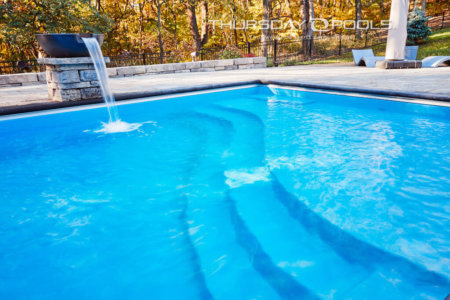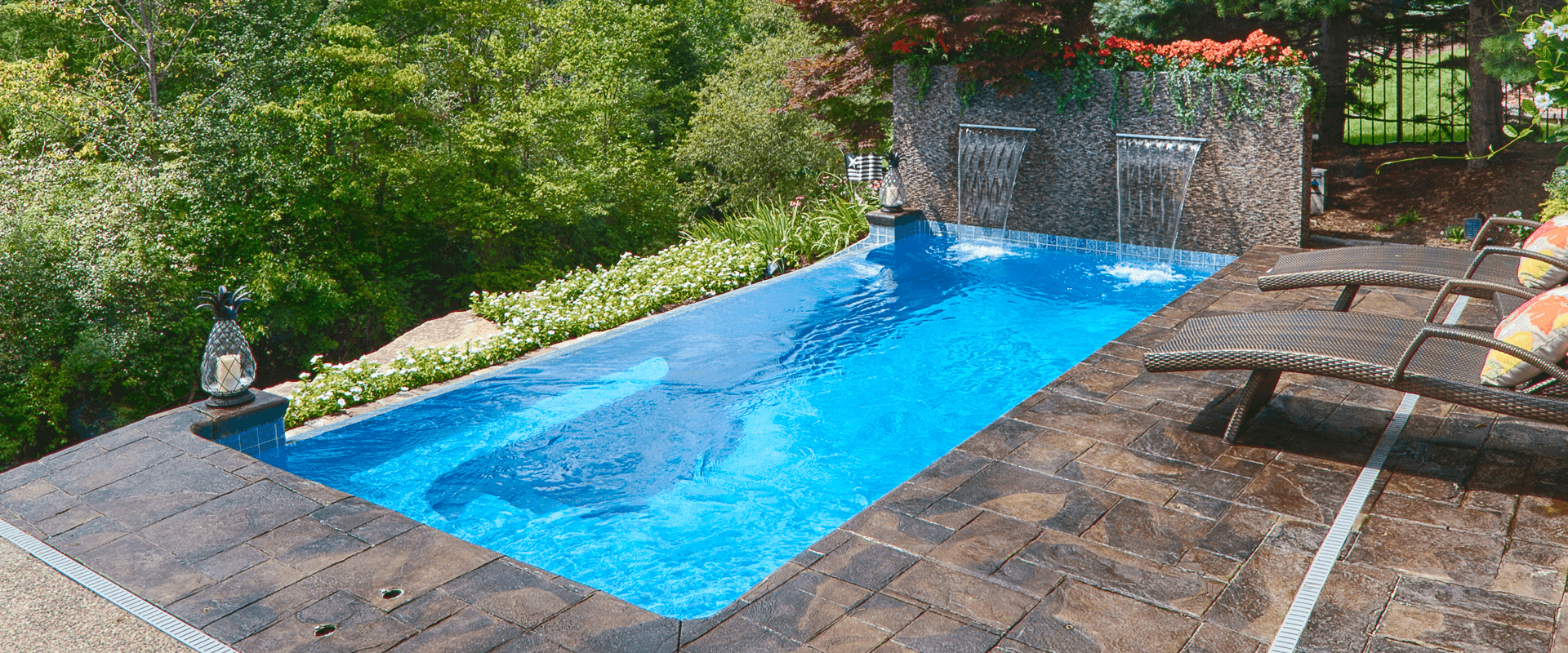877-929-7665
What Type of Inground Pool is Most Cost-Effective? Comparing Inground Pool Types
Whether or not you have unlimited funds to build a pool, you probably wouldn’t buy one without considering how much an inground pool costs. Perhaps you ended up on this blog post by searching, “What type of pool is most cost-effective?” or “What kind of inground pool is cheapest to build?” or even “What type of pool is cheapest to maintain?” Regardless of how you got here, the honest answer to these questions is, “It depends.” Inground pools come in three main types: gunite (concrete), vinyl liner, and fiberglass. The initial purchase price, as well as lifetime costs, vary depending on the type you choose. Let’s explore the costs associated with each type of inground pool, breaking down their installation prices and some of their long-term maintenance costs to help you make an informed decision.
Vinyl Liner Pools
Vinyl liner pools are often considered a budget-friendly choice, making them popular among homeowners seeking to minimize upfront costs. However, higher maintenance and replacement expenses can offset the lower initial investment over time.
- Initial Purchase Price: The average cost of installing a vinyl liner pool is between $25,000 and $65,000. This cost covers basic installation but does not account for long-term upkeep or customizations. For our calculations, we’ll use $65,000.
- Liner Replacement: Vinyl liners need replacing approximately every ten years. Each replacement costs between $3,000 to $7,500, averaging about $5,250 per replacement. Over a 25-year lifespan, expect to replace the liner twice, totaling about $10,500.
- Filter Cartridge Replacement: The filter cartridges need replacement every three years, costing between $250 and $1,200, averaging $725. Over the pool’s lifespan, replacing filter cartridges eight times would cost approximately $5,800.
- Pool Pump Replacement: On average, pool pumps typically need replacing every ten years, costing between $300 and $2700 per pump. With an average cost of $1,500 each time, pool pumps add up to $3,000 over 25 years.
- Heater Replacement: The pool heater, essential for maintaining comfortable water temperatures, usually requires replacement once every 11 years. At $3,400 per heater, heater replacements cost $6,800 over the life of the pool.
- Chemicals, Opening & Closing: The average cost of pool chemicals for a vinyl liner pool is about $400 per season, totaling $10,000 over 25 years. Additionally, opening and closing the pool each year costs approximately $325 and $375, respectively, leading to a combined cost of $17,500 over 25 years.
- Total Cost Over Lifetime: Adding up all these expenses, the total lifetime cost of a vinyl liner pool is approximately $118,600, averaging $4,744 per year. While vinyl liner pools offer a lower upfront cost, the regular need for liner replacements and other maintenance makes them more expensive over time.
Gunite (Concrete) Pools
Gunite pools are known for their durability and customization options. They are often the go-to choice for homeowners wanting a pool that can be uniquely shaped and designed. However, these benefits come at a higher cost.
- Initial Purchase Price: The average cost of installing a concrete pool is between $50,000 and $120,000, making it the most expensive option upfront. This price reflects the complex construction process involving hand-shaping the pool with rebar and concrete. We’ll use $120,000 for our calculation.
- Resurfacing (Plaster Refinishing): Concrete pools require resurfacing every ten years to maintain their integrity and appearance. Each refinishing costs $6,000 to $15,000, or $10,500 on average. Over 40 years, you may resurface the pool four times, totaling $42,000 over the pool’s life.
- Filter Cartridge Replacement: Similar to vinyl pools, concrete pool filters need replacing every three years, costing about $725 each time. Over the pool’s 40-year lifespan, this adds up to approximately $9,425.
- Pool Pump Replacement: Concrete pools usually require pump replacements every ten years at $1,500 per replacement, totaling about $4,500 over the pool’s lifespan.
- Heater Replacement: With three $3,400 replacements over 40 years, the cost adds up to $10,200.
- Chemicals, Opening & Closing: Concrete pools require more chemicals, costing around $750 per season due to their porous surface. Over 40 years, chemical costs alone reach about $30,000. Annually opening and closing the pool adds another $28,000 over the pool’s lifespan.
- Total Cost Over Lifetime: Including all necessary replacements and maintenance, the total lifetime cost of a concrete pool is estimated at $244,125, averaging $6,103 per year. While concrete pools offer the most customization, their higher initial cost, high maintenance needs, and resurfacing costs make them the most expensive option.
Fiberglass Pools
Fiberglass pools are often considered the most cost-effective inground pool option. These pools are pre-molded and installed in one piece, lowering construction and maintenance costs.
- Initial Purchase Price: Installing a fiberglass pool costs between $30,000 and $85,000. This price reflects the ease of installation and the lower labor costs compared to concrete pools. Like the other pool types, we’ll use the higher end, $85,000, for our calculations.
- Refinishing: Fiberglass pools don’t need resurfacing as long as they are well-maintained and the water remains balanced, providing significant savings over the life of the pool.
- Filter Cartridge Replacement: Fiberglass pool filters need replacement every three years, costing $725 each time. Over a 60-year lifespan, expect to spend about $13,775 on filter replacements.
- Pool Pump Replacement: The average lifespan of a pool pump is about ten years, with replacements costing around $1,500 each time. Over 60 years, this totals approximately $7,500.
- Heater Replacement: Pool heaters for fiberglass pools need replacement every 11 years. Over 60 years, at an average of $3,400 per instance, this cost adds up to $17,000.
- Chemicals, Opening & Closing: Fiberglass pools have smooth, non-porous surfaces that resist algae, significantly reducing the need for chemicals. On average, expect to spend about $175 per season on chemicals, totaling $10,500 over the pool’s lifetime. Annual opening and closing costs are around $325 and $375, equaling $42,000 over 60 years.
- Total Cost Over Lifetime: The total lifetime cost of a fiberglass pool is about $175,775, with an average annual cost of $2,930. These pools offer the best value due to their durability, low maintenance, and long lifespan.
Which Pool Type is Most Cost-Effective?
While vinyl liner pools have the lowest upfront cost, their ongoing maintenance and liner replacement needs add up. Though highly customizable, concrete pools have the highest initial and long-term costs. As demonstrated in the lifetime calculations, fiberglass pools balance durability, low maintenance, and overall cost, making them the most cost-effective choice over time. Try our fiberglass pool cost calculator for a ballpark estimate of your pool installation, or schedule a consultation with a builder for advice and a detailed estimate.
